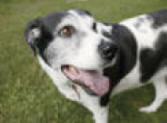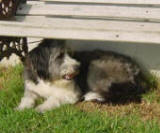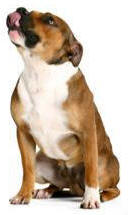
 "Come"
is the most important word your
dog can learn to obey. Unlike
"sit" or "stay"
in the right circumstance, "come"
could save his life. Consider
the "come" Instruction
to mean,
come and sit
in front of me and look into
my eyes. If the dog doesn't
know how to "sit",
then start by rewarding him for coming
to you. You can always refine
a behavior later on. Eventually,
try for the combination of "come"
and "sit" and "touch
the collar." Otherwise, he may just
come near you which isn't
good enough if you need to put
him on leash.
"Come"
is the most important word your
dog can learn to obey. Unlike
"sit" or "stay"
in the right circumstance, "come"
could save his life. Consider
the "come" Instruction
to mean,
come and sit
in front of me and look into
my eyes. If the dog doesn't
know how to "sit",
then start by rewarding him for coming
to you. You can always refine
a behavior later on. Eventually,
try for the combination of "come"
and "sit" and "touch
the collar." Otherwise, he may just
come near you which isn't
good enough if you need to put
him on leash.
It is VERY helpful to have your
dog drag a long line or lead (10
- 25 feet) on your dog at all
times when you begin the
instruction phase through the
reinforcement stage of learning.
You can "reel" the dog in after
giving the instruction and
praise - not too
enthusiastically - like it was
your dogs idea but no treats.
NEVER call your dog if you have
any doubt about compliance. Go
closer to the dog or wait until
the major distraction has
passed.
|
You
must be sure you don't
accidentally teach that "come"
is a bad word. Never
call the dog - for ANY
reason
that does not result in a
wonderful outcome for the
dog. NEVER scold or
punish the dog after he or
she comes
to you. |
 If you
must correct him, go to the
dog. As your scolding,
insist on a
"sit" in a Instructioning voice.
Once sitting,
all is
forgiven.
If you
must correct him, go to the
dog. As your scolding,
insist on a
"sit" in a Instructioning voice.
Once sitting,
all is
forgiven.

Change your
tone of voice to friendly, when
you ask the dog to "come" to
you. Ask, one time only when you
have the leash in hand and can
be sure the dog will not run
off. Crouch if the dog will not
come when you are standing.
Encourage the dog with happy
noises, hand clapping, etc.
From this day forward, NOTHING
good happens without you calling
your dog to you, "Petname,
come!" first. Now, life rewards,
strengthen your dog's response
to your clear instruction. Call
your dog for
dinner,
for play, for attention, for
walks, for EVERYTHING. If your
dog does not come, turn your
back, walk away and give no
attention. Hold back rewards
until your dog has EARNED them
by following at least one
instruction first.
Control feeding
by giving 2 meals instead of
leaving food down. By doing
this, your dog will see you
as the leader and provider of
food. This strategy also provides
the daily opportunity to train
your dog for a few minutes before
each meal.
|
To
start teaching the dog to come
on cue, first praise the dog
whenever
he/she comes to you. |
 In
a very short time, your dog will
learn the dinner routine and be
waiting (or cheerleading) while
you fix dinner. Use
the first few kibbles of every
meal to practice your dog's
human vocabulary. Praise
compliance and offer kibbles or
small treats as you go.
In
a very short time, your dog will
learn the dinner routine and be
waiting (or cheerleading) while
you fix dinner. Use
the first few kibbles of every
meal to practice your dog's
human vocabulary. Praise
compliance and offer kibbles or
small treats as you go.
The
next step is to work on
"come"
(still inside the house), but
not at the usual dinner time
or place. Hide some dog cookie jars in a few places around
the house where you spend time.
The jar will remind you to practice
training the dog. When you know
the dog is in the house but
nowhere to be seen, take out
the treat and say, "Fido,
Come." When he
comes to you, surprise him with
a treat.
|
End your training sessions
after the quickest and best
responses. Then, give the
dog his dinner or share a
play session or walk.
|
After
your dog has learned
"come"
at home, you must practice while
walking the dog on the leash.
Although this might seem odd,
the goal is to control the process
outdoors while you're
not confined in the house. Make
the dog
"Sit-Stay".
Then,
you back away to the length
of the leash. Say "Fido,
Come". Give small,
short tugs on the leash to get
him started. Do NOT "reel him
in" with continuous pressure. If
needed, hook two leashes
together to give you a longer
recall distance. If he
errs, make him do at least one
good response before going on
your way.

Here's another trick to teach
him to come when off-leash.
Start in a fenced area, like a
tennis court. Let the dog drag
the leash. After a few
seconds, when he gets 10 to 15
feet away, call him back to you.
If he comes, give a treat and
return the freedom. If he
doesn't go to him and ask for a
SIT.
Practice
COME for a few minutes
during walks to help your dog
learn that coming earns more
walk time! It may be easier to
practice toward the end of the
walk once your dog has expended
some energy.
|
Make it in your dog's best
interest to have the leash
go back on after an off
leash outdoor
excursion. Help the
dog to associate going home
with a special reward such
as dinner or a favorite toy
or treat.
|
If
there is a safe off-leash area,
a common mistake is to
arrive, remove the leash and
allow the dog to run and play.
When the time comes to leave,
he may not want to give up the
fun and may be difficult to catch.
This makes it less fun for you
to take him out.
To solve this
problem, when you first let
him off leash, call him back
immediately, and give a treat. If he
comes quickly, the reward he gets
is to go play again. If
he doesn't come, you go
and get him and keep him on
a short lead for several minutes working on the "come-on-leash" exercise described
above. When he will come reliably,
very gradually, allow longer
periods of freedom.
ALWAYS walk
your dog before a meal when
he/she is hungry.
You want your dog to be
successful so teach in
baby steps and
progressive stages: 1 -
in home in sight, 2 - in
home out of sight, 3 -
in home with mild
distractions, 4 - up the
distractions, 5 -
outdoors no
distractions, 6 -
outdoors with minor
distractions, etc.
|
Always call
him back when he travels to
the edge of the distance from
which you feel you have reliable
control. Lavishly
praise all correct
responses. Use food
treats as needed as
reinforcements. |
Establish
the distance you will allow
freedom by choosing the distance you
allow him to wander before requiring checking
in with you. When you are confident the
dog will come to you EVERY
time - even with distractions
(bouncing ball, squirrel or cat)
then try it in a safe, open
space.